Back to Godhead: New Vrindaban – An Overview in Honor of Its 50th Anniversary
Back to Godhead Magazine, January/February 2018 issue
New Vrindaban: An Overview in Honor of Its 50th Anniversary
By Satyaraja Dasa
Archival Research by Chaitanya Mangala Dasa
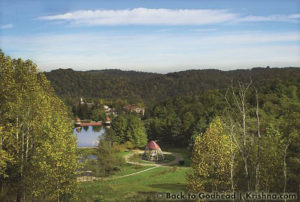
A view from Govardhan Hill of Sri Sri Radha Vrindaban Chandra’s temple and guest lodge, with Kusum Sarovara Lake and the peackock and swan aviary in the foreground.
With the successful worldwide celebration of ISKCON’s fiftieth anniversary in 2016, another semicentennial event naturally follows in its wake: commemoration of the founding of New Vrindaban in 1968, two years after ISKCON’s founding. By establishing this farm community, Srila Prabhupada hoped his followers and eventually the rest of the world would embrace the Krishna conscious ideal of “simple living and high thinking.” This could be accomplished, he taught, by underscoring five important components of a back-to-the-land Vedic ideal, beginning with (1) cow protection, (2) simple living, (3) spiritual education, and (4) holy pilgrimage. Under the right direction, he added, these four can lead to the most important component of all: (5) loving Krishna.
This article has two parts. The first is an overview of New Vrindaban – what it is, how it started, and what it has accomplished. The second focuses on four devotees who bring to life the five components that Prabhupada mandated for New Vrindaban. While the community has produced a multitude of devotees who could be singled out for their consummate service, these four, each with a penchant for one of the initial components mentioned above, will serve as a sample. Their stories show how the fifth component, loving Krishna, is the natural result of properly engaging in New Vrindaban’s central activities.
Part I: Origins and Development

Srila Prabhupada delivers his Bhagavat Dharma discourses during the 1972 Vyasapuja & Janmastami celebrations on Govindaji Hill at the Bahulaban farm.

Srila Prabhupada tours his under construction Palace during his final visit to New Vrindaban in 1976
Vrindavana is Krishna’s paradise in the spiritual world, the kingdom of God described in the ancient wisdom texts of India. A replica of this realm exists even today as a village in the Mathura district of Uttar Pradesh, India, where Krishna walked the earth some five thousand years ago. Soon after Prabhupada arrived in the West, in 1965, he envisioned yet another replication of Vrindavana – New Vrindaban.1
In May 1956, Prabhupada wrote a two-part Back to Godhead article about the potential for such a project in the Western world. The article promoted the notion of a community of devotees living close to nature according to the principles of the Bhagavad-gita. He called the project Geeta Nagari (the name of his subsequent farm in Port Royal, Pennsylvania).
Vrindavan’s initial Western counterpart came to be through the agency of two early disciples, Kirtanananda Swami and Hayagriva Dasa. In the winter of 1968 they saw a brief newspaper article in which an enterprising landowner-turned-yogi, Richard Rose, mentioned that he was looking for people to create an ashram in Marshall County, West Virginia. “The conception is one of a non-profit, non-interfering, non-denominational retreat or refuge,” read the almost prescient article, “where philosophers might come to work communally together, or independently, where a library and other facilities might be developed.”2
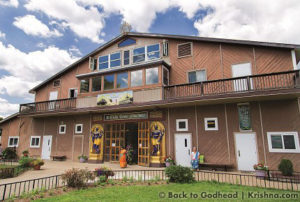
The front entrance to Sri Sri Radha Vrindaban Chandra’s temple, guarded by Jaya and Vijaya, the Vaikuntha Gatekeepers.
Several months later, Kirtanananda and Hayagriva, who had temporarily developed a strained relationship with their spiritual master, set out on their own to visit the land. They negotiated with the owner and reached a provisional financial agreement. Kirtanananda settled there for a few months in a farmhouse in the woods.
That summer, he and Hayagriva visited Prabhupada in Canada to make amends. His Divine Grace “forgave his renegade disciples in Montreal with a garland of roses and a shower of tears.”3 With Prabhupada’s approval they returned to West Virginia and leased the property. A month later Prabhupada wrote to them, “Now we can work with great enthusiasm for constructing a New Vrindaban in the United States of America.”4
Excited about his new project, Prabhupada had his secretary, Brahmananda Dasa, write to the various ISKCON centers asking those devotees who were able and inclined to support New Vrindaban by visiting if not staying on and lending manpower.5 He had already given the land its special name in an earlier letter: “You have New York, New England, and so many ‘New’ duplicates of European countries in the USA, why not import New Vrindaban in your country?”6
Soon after the arrival of Brahmananda’s letter – that same month, in fact – New Vrindaban’s first deities of Sri Sri Radha-Krishna made Their appearance as well: A small pair of bell-metal murtis, compliments of a devotee who had just returned from India. Prabhupada was delighted. “I am very glad to learn that Harivilas has given you a pair of Radha-Krishna Murtis, so it appears that Radha-Krishna is very kind on you, because you went to Vrindaban to live there but circumstantially, you could not live there, and you left. Krishna has given you New Vrindaban, as well as, out of His good will, He has come to you. It is very surprising. So please welcome the Deity and install Him in a nice throne.”7 These deities would eventually be called “Little Radha–Vrindaban-Chandra,” after the main deities of the temple, installed three years later. Also in 1968, Kirtanananda brought from Montreal Jagannatha deities to be worshiped on the community’s small altar.
With deity worship in place, a set of clear instructions from their spiritual master, and new devotees trickling in, New Vrindaban developed, steadily if also slowly. Despite frigid winters and austere conditions, sincere and determined devotees gradually made the journey and helped develop the small, humble ashram into a thriving Krishna conscious village. Cows, central to the New Vrindaban paradigm, were soon bought and bred. Calves were born, and a very real bovine presence gave the land the feel of its namesake. Hand-tended gardens were set in place, providing food for the community and flowers for the deities. Oxen and horses were trained to pull plows and wagons, resulting in small agricultural miracles. The fields gave birth to crops of corn and hay, harvested and stored in silos for the cows to eat during New Vrindaban’s cold winters. All the while, devotees were learning the philosophy of Krishna consciousness under senior disciples. Simple living, high thinking.
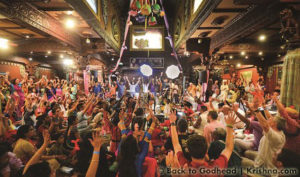
Devotees blissfully raise their arms and Chant Hare Krishna during one of New Vrindaban’s biannual 24 Hour Kirtan festivals.
Spring of 1969 saw Prabhupada’s first visit to the farm, and he loved it. He stayed a little over a month, but he made it clear that New Vrindaban was home. After he left, he continued to guide his disciples on transcendental life in a rural environment through many letters and even a few subsequent visits, in 1972, 1974, and 1976.
By August 1970 almost fifty residents were living at the community, and the number would keep growing. Beautiful hand-carved white marble deities were imported from India and installed on Janmashtami, August 13, 1971, and after that, New Vrindaban grew like wildfire.
Throughout the 1970s, cows, peacocks, and additional land were acquired, until New Vrindaban –initially some 138 acres – would eventually boast nearly 2,500, with devotees anxious to join from all quarters.
Hayagriva wrote in 1972: “In ’69 and ’70 we built cottages and gradually expanded to include a dozen people. Then in the winter of ’70, we began making Spiritual Sky incense and distributing it through the city temples. This proved to be a real gold mine. By the spring of ’71 sufficient money came in to enable us to buy the other two farms [nearby], and as soon as we did people started pouring in.”8 Kirtanananda Swami became a leading ISKCON sannyasi, and his project became one of ISKCON’s premier pilgrimage sites, with devotees worldwide attending its many annual festivals.
A tour de force development was Prabhupada’s Palace of Gold. (See my article in Back to Godhead, May/June 2016.) Conceived in 1972 as a comfortable residence for Prabhupada whenever he visited New Vrindaban, it was still unfinished when he departed this world in November 1977. The idea morphed into its being a memorial shrine, and with that vision the devotees continued to work on it as a lasting tribute to Srila Prabhupada. Upon its completion in 1979, it exceeded everyone’s wildest dreams – a dazzling, highly wrought, even otherworldly palace of marble, gold, carved teakwood, and the blood, sweat, and tears of numerous dedicated devotees – a fitting tribute to the modern world’s greatest spiritual master.
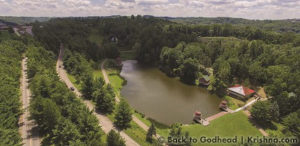
An aerial photo of the heart of New Vrindaban. Srila Prabhupada’s Palace is on the upper left. Thirty foot tall Gaura Nitai sculptures can be seen in the center, just above Kusum Sarovara Lake and below Govardhan Hill. To the right are cabins, Yogashala and Community Gardens.
“It’s hard to believe that Prabhupada’s Palace is in West Virginia,” wrote the Courier-Journal of Louisville, Kentucky. “In fact, it’s hard to believe it’s on this planet.”9 Life magazine told readers that the Palace is “a place where tourists can come and be amazed.”10 The New York Times summed it up: “Welcome to Heaven.”11 The Palace was unquestionably a highpoint in New Vrindaban’s achievements, and throughout the 1980s it reaped the benefits of the devotees’ monumental endeavor.
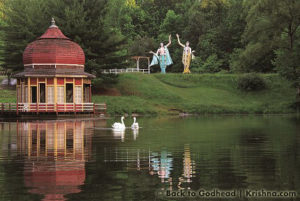
Swans gracefully glide across the lake in front of Sri Sri Radha Vrindaban Chandra’s boat house and Gaura Nitai.
Unfortunately, Kirtanananda Swami, though a qualified and noble leader in many ways, temporarily brought New Vrindaban to its knees, leading it into questionable and deplorable realms, some illegal, for which he was reprimanded and given a jail sentence, as were others. Naturally, the Governing Body Commission of ISKCON deposed him, for his wayward activity was not representative of the movement’s ideals and teachings. Thus he was excommunicated from the movement in 1994.
Throughout the 1990s and into the early years of the twenty-first century, New Vrindaban suffered, even as the Palace, at first, continued to thrive and receive many visitors. But signs of decay soon appeared. New Vrindaban’s troubles became the stuff of books and news articles, causing even sincere followers to leave. Various deviations continued to occur. As a result, from the early 1990s until only recently the Palace suffered financially, causing maintenance to be neglected and an overall downward spiral, but one that was not to last.
As the first decade of the twenty-first century came to a close, a new day dawned, and New Vrindaban started to rebuild. By 2011 a new team of dedicated devotees picked up where the old crew had left off, with some of the older devotees staying on and gaining new momentum. New acolytes joined hands with New Vrindaban stalwarts and worked diligently to revamp the original spiritual vision of Prabhupada’s first farm community. It is now on solid ground, with the community learning from previous mistakes. Indeed, fifty thousand tourists and pilgrims still visit each year.12In recent years an ambitious multi-million dollar renewal effort has been set in place, with an enthusiasm that rivals the Palace’s initial construction.13
Part II: The Five Principles of New Vrindaban
Here we briefly survey the five components that Prabhupada mandated for New Vrindaban: (1) cow protection, (2) simple living, (3) spiritual education, (4) holy pilgrimage, (5) and loving Krishna.
- Cow Protection

Sukhayanti Dasi, Nila Gopala Dasa, and their two young daughters, Sudevi and Rangadevi, greet Sriya at the community’s Nandagram Farm.
“Krishna by His practical example,” Prabhupada wrote, “taught us to give all protection to the cows, and that should be the main business of New Vrindaban.”14 Apropos of this, New Vrindaban is home to the first and longest-running cow-protection program in ISKCON and the Western world. It has been in operation since the spring of 1969, when the community’s first cow, Kaliya, made her way into the association of devotees. The heroes who have championed the cow program at New Vrindaban are many, but one devotee in particular has worked hard to make this a reality.
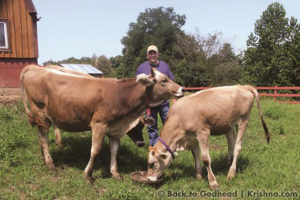
Ranaka Dasa, who has steadily cared for the cows in New Vrindaban for more than 40 years, stands with the three heifers shown in a previous photo.
Doug Fintel was born in 1954 in Norfolk, Virginia. Raised on a farm in northwest Iowa, he migrated to the mountains outside Denver, Colorado, where he deepened his love for nature. His involvement in the counterculture of the 1960s reached a highpoint when he met the devotees of Krishna, particularly Padmanabha and Mahotsava, a husband-and-wife team looking for interested seekers in that part of the country. Doug had started a firewood business, but the devotees won his heart, and he began to think how he could engage as one of them more directly.
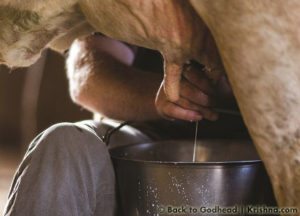
Twice daily, every day of the year, Ananda Vidya Dasa and Lalita Gopi Dasi lovingly milk the protected cows that provide dairy products for the deities and devotees.
Frequenting the Denver ISKCON temple in the winter of 1976, he liked the idea of a farm community dedicated to Krishna, and New Vrindaban seemed a natural fit. His general psychophysical makeup and his background in rural America made him just the right man for a back-to-the-land Krishna conscious environment, especially for the plow department and farm work. He has been in New Vrindaban, serving faithfully, since before Prabhupada’s departure from this world. In fact, he had heard about Prabhupada’s love for New Vrindaban’s cow-protection program soon after he joined ISKCON in 1977. New Vrindaban was abuzz with Prabhupada’s recent visit. Madhava Smullen writes,
In 1976, when [Prabhupada] visited New Vrindaban for the last time, the community was caring for four working teams of oxen and over 150 cows. A new barn had been erected in Bahulaban [one of New Vrindaban’s first sectors], and Prabhupada visited it to see the cows and four newborn calves. He let one of them lick his hand as a devotee told him how the cows were yielding about 120 gallons of milk every day, which they were turning into ghee, cheese and buttermilk. Prabhupada was pleased.15
Doug, initiated as Ranaka Dasa, gradually became more and more involved with New Vrindaban’s cows and is now, with their help of course, producing “ahimsa milk” – consciously trying to avoid any pain for the dairy cows on the farm.
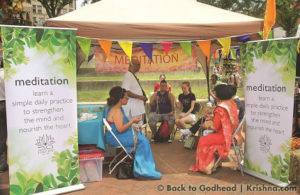
New Vrindaban devotees show festival participants how to chant japa during the second annual Wheeling Ratha Yatra.
Ranaka is looking for a sustainable model for the future.
“In the past,” he says, “New Vrindaban was known for its huge dairy production, but we couldn’t take care of the cows properly. So we’re looking for balance, a sustainable model for the future, where the cows are happy and produce in abundance. I think we’re getting there.”
- Simple Living
Prabhupada sometimes referred to self-sufficiency with the phrase “simple living,” reminiscent of his ISKCON Statement of Purpose #6: “To bring the members closer together for the purpose of teaching a simpler and more natural way of life.” Using the things of this world in God’s service is real renunciation, or saintly life. It is called yukta-vairagya. As Prabhupada wrote: “Yukta Vairagya means that we should simply accept the bare necessities of our material part of life, and try to save time for spiritual advancement. This should be the motto of New Vrindaban.”16
One New Vrindaban devotee who embodies that mood is Vidya Devi Dasi. Born in Wisconsin as Mary Smith in 1949, she and her husband, Madhava Ghosha, now deceased, came from rustic, agrarian backgrounds and had always put a premium on intelligent agriculture, even before they joined Prabhupada’s farm community. Her ancestors were among the first settlers in Wisconsin, developing sophisticated agronomical techniques early on.
“It’s in my DNA,” she says. “I was born on a farm, and I’ve been living close to the land from childhood.”
She arrived in New Vrindaban in 1972 and met Madhava a few years after settling there. They devoted their lives to gardening for Krishna, growing vegetables and flowers for the community while raising their five children. She’s especially fond of the gorgeous and variegated gardens at Prabhupada’s Palace, which she nurtured from the ground up, their beauty competing with the Palace itself.
But even prior to the Palace, she and the other New Vrindaban farmhands performed natural miracles. By 1974 the Bahulaban temple garden expanded to 1.5 acres, with similar large gardens in the sections of New Vrindaban known as Vrindaban and Madhuban. Plantings included more than thirty kinds of vegetables, fruits, and herbs, along with oats, which became a staple in New Vrindaban.
Teams of horses plowed the fields. Devotees involved included Varshana Swami (then Kashyapa Dasa), Tejomaya, Manonatha, Madhava Ghosha, Advaitacharya, and Tapah-punja, among others. A greenhouse, built in 1975, extended growing periods and allowed flower growing during winter.
Vidya also started a side business, called Nature Crafting. She would grow and sell tomatoes, herbs, flowers, and other crops, and she would teach the locals the value of organic gardening for both consumers and the environment. She laughs as she remembers how they would grow gourds of all shapes and sizes. These became among their most popular items. She would paint them and turn them into birdhouses and even Jagannatha deities, which sold well. Prabhupada’s strong endorsement for this kind of work came in 1976: “Yes. Anything grown in the garden, that is hundred times [more] valuable than [if] it is purchased from the market.”17
ECO-Vrindaban (ECO-V), a nonprofit organization, was started in 1998 to care for New Vrindaban’s cows, and in 2014 it also took responsibility for locally grown crops and flowers, continuing and expanding New Vrindaban’s self-sufficiency program. By caring for New Vrindaban’s bovine life, particularly by milking its happy and productive dairy cows, and by developing sustainable agriculture, ECO-V has been realizing Srila Prabhupada’s vision of simple living for the devotee community.
- Spiritual Education
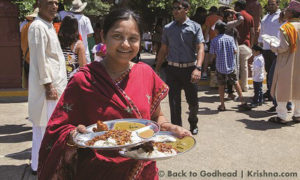
Pilgrims enjoy tasty prasadam outside Sri Sri Radha Vrindaban Chandra’s temple during Labor Day festivities September 2017.
Prabhupada often said that people are suffering due to a lack of knowledge. His hope was that through spiritual education, people would become happy. This aligns with his ISKCON Statement of Purpose #1: “To systematically propagate spiritual knowledge to society at large and to educate all people in the techniques of spiritual life in order to check the imbalance of values in life and to achieve real unity and peace in the world.”
Prabhupada wrote, “It is necessary for the leaders of the Krishna consciousness movement to start educational institutions in different parts of the world to train children, starting at the age of five years. Thus such children will not become hippies or spoiled children of society; rather, they can all become devotees of the Lord. The face of the world will then change automatically.”18
Specifically for New Vrindaban, he wrote, “Please now try to organize a children’s school. This is one of our programs in New Vrindaban. . . . You can form a school committee and get it recognized by the Education Board. Then more children will be sent.”19 The realization of Srila Prabhupada’s educational dream for New Vrindaban has been spotty, with various successes and failures. But the community continues to keep the goal in mind, and various attempts are being made to implement both children’s schooling and higher education.
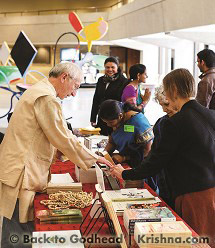
Sankirtan Dasa & Ruci Dasi greet guests after a Mahabarat dramatic storytelling at the University of Cincinnati.
Sankirtana Dasa and Ruci Devi Dasi, Andy and Ruth Fraenkel, are two names that stand out in the realm of New Vrindaban education. The couple met in college in 1968, were initiated in 1973, and arrived in New Vrindaban by 1976. And for the next forty years, Ruci, especially, dedicated herself to teaching preschool and elementary school to prepare children for a life of devotional service to Krishna, but no less for the rigors of living in the outside world. While Sankirtana has underlined the importance of education through storytelling and dramatic performance, for which he has won significant accolades and awards, Ruci has concentrated her focus on schools and an academic environment.
Way back in the 1970s when the New Vrindaban school was called Nandagram, the small classrooms for boys and girls gradually grew into one of the largest ISKCON gurukulas in the world. But the ashram-based facility was shut down by the end of the 1980s. Then, from 1989 to the late 1990s, there was a day school, which grew into Gopal’s Garden, opened by Ruci in 2007. Gradually, the New Vrindaban educational system evolved into a homeschooling cooperative that keeps improving.
“Today,” writes Madhava Smullen, “[Ruci] continues to teach at the Gopal’s Garden Homeschool Co-op, established in 2007.” There she provides a balanced blend of standard academic subjects and Krishna conscious education. At the end of each school year, she produces an anthology of the students’ writings and illustrations, now used in ISKCON schools worldwide.
- Holy Pilgrimage
Among the several farm projects and rural communities started by Srila Prabhupada, only New Vrindaban was given the mandate to build replicas of holy places of Vrindavan: “There will be seven principal temples, namely, Govinda, Gopinatha, Madana Mohana, Syamasundara, Radha Ramana, Radha Damodara, and Gokulananda.”20
Thus, from its inception New Vrindaban was seen not only as a pilgrimage site in its own right, but also as a reproduction of the original pilgrimage site – Vrindavan itself, home to the original temples of the Goswamis, leading followers of Lord Chaitanya.
“Activities exhibited by Krishna Himself at Bhauma Vrindavana, the Vrindavana-dhama existing on this planet,” wrote Srila Prabhupada, “are not different from His activities on the planet Goloka Vrindavana. This is proper realization of Vrindavana anywhere. In our Krishna consciousness movement we inaugurated the New Vrindavana activities, wherein devotees are always engaged in the transcendental loving service of the Lord, and this is not different from Goloka Vrindavana.”21
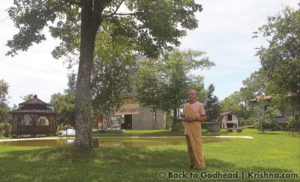
Varsana Swami stands near Radha Kunda, with the partially completed Radha Gopinath Mandir in the background.
One person who has taken the pilgrimage aspect of New Vrindaban to heart is Varshana Swami. Born John Mowen in 1950, he hails from Morristown, New Jersey, but spent many of his early years on his grandfather’s farm in Pulaski, in upstate New York. He also studied theology at St. Andrew’s College, but quickly decided that he could best pursue God in the forest, where he could pray and contemplate divinity without disturbance.
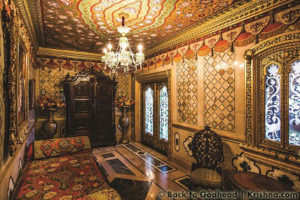
Prabhupada’s bedroom has walls inlaid with Italian Botticino marble and a ceiling with nearly one thousand hand-painted flowers.
It was in the forest that he met the devotees. He returned with them to the Brooklyn temple and took up devotional practices. This was in 1972. Relocating to New Vrindaban, he was initiated by Prabhupada a year later. He has been there ever since.
Varshana Swami gradually became known for landscaping, carving the holy area out of the existing contours of the West Virginia foothills. He has “excavated” replicas of Radha-kunda and Syama-kunda at Govardhana Hill in New Vrindaban, and is gradually constructing Radha-Gopinatha Mandir, the first of Srila Prabhupada’s proposed replicas of the seven main temples of Vrindavan. This has become a prized pilgrimage spot for visitors. As time goes on, the other temples will manifest as well, and pilgrims will come from all over the world, as they do now to see the Palace of Gold. Varshana Swami clearly has a calling to liberate these holy places from the raw landscape that is New Vrindaban.
- Loving Krishna
Ultimately all four of the above components work in concert to bring about love for Krishna, the fifth, if also the primary, principle of the New Vrindaban way of life. The third of the seven purposes of ISKCON is “To bring the members of the Society together with each other and nearer to Krishna, the prime entity, thus developing the idea within the members, and humanity at large, that each soul is part and parcel of the quality of Godhead (Krishna).” This is where New Vrindaban ultimately hopes to take the people who live there, and to carry all its visitors on that journey as well.
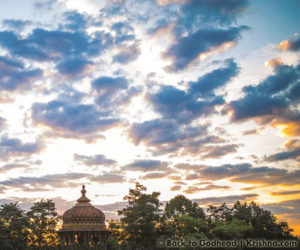
Sunrise seen through one of the four corner chattras that adorn the exterior terrace of Prabhupada’s Palace
Notes
- The earthly replica of Vrindavana in the spiritual world is spelled “Vrindavan” on modern maps. Srila Prabhupada used the Bengali-style spelling when naming “New Vrindaban.”
- Richard Rose, The San Francisco Oracle, December 1967.
- Hayagriva Dasa, “Chant,” Brijabasi Spirit, November 1981, p. 20.
- Letter from Prabhupada, 8/23/68. Quoted in Hayagriva Dasa, “New Vrindaban,” in Back to Godhead, Feb. 1, 1969 (Vol. 1, No. 23). Online version: http://www.backtogodhead.in/new-vrindaban-hayagriva-dasa/
- Brahmananda’s letter, dated September 7, 1968, and approved by Prabhupada, summed up their master’s vision for New Vrindaban in those earliest days: “It has a farmhouse and several other structures, a well, streams, hills (Govardhan, as named by Swamiji [Prabhupada]), pasture grounds (a cow will be acquired soon), ghat, pond, woodland, all situated on 138 acres. Prabhupada has requested that 7 temples be established there. Its main activity will be cow protection and to show the world that simply by living with cows and land and chanting HARE KRISHNA a perfect society will prevail. . . . A great deal of work is required and Swamiji has requested at least four devotees to go there immediately. New Vrindaban lacks [such] so-called necessities as hot running water and toilets, so that only stout and sturdy devotees are needed, especially those with carpentry experience and can do manual labor.”
- Srila Prabhupada letter to Hayagriva, 3/17/68.
- Srila Prabhupada letter to Kirtanananda Swami, 9/22/68.
- Howard Wheeler, “New Vrindaban: A Hare Krishna Community in West Virginia,” Mother Earth News,July/August 1972.
- “Children of Krishna: Seeking heaven in West Virginia,” Courier-Journal Magazine (Sunday, February 10, 1980).
- Hillary Johnson, “Children of a Harsh Bliss: In a West Virginia Commune, an Extraordinary Look at Life and Love Among the Krishnas,” Life(April 1980).
- Edward Schumacher, “West Virginia Marvels at Indian Palace,” The New York Times(Monday, September 3, 1979).
- Sarah Pulliam, “A lower-key kind of Krishna,” Columbus Dispatch(July 18, 2008).
- http://www.palaceofgold.com/history.html
- Srila Prabhupada letter to Hayagriva, 6/14/68.
- http://www.brijabasispirit.com/2016/01/07/srila-prabhupada-kaliya-iskcon…
- https://vanisource.org/wiki/680614_-_Letter_to_Hayagriva_written_from_Montreal
- https://vanisource.org/wiki/760803_-_Conversation_C_-_New_Mayapur
- Srimad-Bhagavatam4.12.23, Purport.
- https://vanisource.org/wiki/691207_-_Letter_to_Ranadhir_written_from_London
- https://vanisource.org/wiki/680823_-_Letter_to_Kirtanananda_and_Hayagriva_written_from_Montreal
- http://vanisource.org/wiki/CC_Madhya_7.69
- http://www.brijabasispirit.com/2016/10/16/new-vrindaban-devotees-serve-P…
About the Author:
Satyaraja Dasa (Steven Rosen) is an initiated disciple of His Divine Grace A. C. Bhaktivedanta Swami Prabhupada. He is also founding editor of the Journal of Vaishnava Studies and associate editor of Back to Godhead magazine.
Extra
Going Forward
On the central altar of the New Vrindaban temple stand Sri Sri Radha–Vrindaban-Chandra – Radha with Krishna as “the moon of Vrindavana.” They are accompanied by deities of Gopala Nathji, Gaura-Nitai, Jagannatha, Baladeva, and Subhadra, and Narasimha and Prahlada. Opened in 1983, the temple is elegant beyond words and competes with the Palace for the devotees’ attention.
But the land and the cows will always hold a special place in the hearts of New Vrindaban residents. Although the landscaping and the development of various farm projects have been ongoing since the community’s inception, there is more to do.
Recently a Yogashala opened just down the road from the main temple, and it hosts courses on yoga, meditation, and kirtana. This is part of a new outreach program meant to augment the Palace as a draw for outsiders. But the Palace is still the main attraction. New Vrindaban remains a holy place for pilgrims and a destination for many Western tourists, mainly because of the Palace of Gold.
Madhava Smullen wrote in October 2016:
It’s a reasonable expectation: this year, overall tourism at Prabhupada’s Palace already increased from 20,000 annually to approximately 30,000. Vrajadhama [now Vrajakishora Dasa, the new manager for Prabhupada’s Palace] attributes this to stronger social media presence, as well as an increasing interest from TV, radio and print media.
“It’s really about getting ourselves out there,” says Vrajadhama. “Because we have so much to offer. People are becoming aware that we’re doing a lot of work here, and that we’re ready to reintroduce ourselves to the world. They’re excited about that, and they want to come and see what we’re up to.”22
Apropos of New Vrindaban’s readiness for the future, the year 2018, its fiftieth anniversary, promises to be a major step forward. Several steps, in fact. To begin, five main events will commemorate the fiftieth in glorious New Vrindaban style. People will come from around the world for two weekend extravaganzas, particularly for congregation/donors, that start off the festival year in March and April. VIP events for West Virginia government officials and ISKCON dignitaries begin in May.
During the summer there will be an open-house weekend for the public, with advertising that is sure to bring busloads of tourists from around the country and devotees from around the world. Finally, the main event will be a huge semicentennial celebration in September, commemorating the founding of New Vrindaban. In addition, all of New Vrindaban’s usual annual events will continue in a bigger and better way, including Gaura Purnima, Nrisimha Caturdashi, Festival of Inspiration, 24 Hour Kirtan, Janmashtami, Radhashtami, Wheeling Rathayatra, Prabhupada’s Appearance Day, and the Festival of Colors.
Timeline
1968
January 22
First known mention of “New Vrindaban” in a letter from Srila Prabhupada.
August 8
Founding of New Vrindaban with Hayagriva’s signing of a 99-year lease.
August 23
Prabhupada’s letter to Kirtanananda and Hayagriva fully authorizing the establishment of New Vrindaban.
1969
Spring
Purchase of Kaliya (the community’s first cow) and the start of ISKCON’s cow-protection program.
May 21–June 22
Srila Prabhupada’s first visit.
1970
August
First New Vrindaban Janmashtami festival.
1971
Winter
Large Jagannatha, Baladeva, and Subhadra carved in Pittsburgh by Nara Narayana Dasa.
August
Janmashtami: Radha–Vrindaban-Chandra installation ceremony at the Vrindaban farmhouse.
1972
May
Bahulaban temple opens, and Radha–Vrindaban-Chandra move there from the Vrindaban farmhouse.
August 31–September 8
Srila Prabhupada’s second visit.
New Vrindaban sees the arrival of its twenty-first cow.
1973
Spring
Guruban property purchased (future site of Prabhupada’s Palace).
June 2–3
Groundbreaking ceremony for Prabhupada’s Palace and Govindaji Temple.
Installation of Radha-Madhava at Madhuban and Radha–Vrindaban-Natha at Vrindaban.
August 23
New Vrindaban Community, Inc. incorporated by Hayagriva, Paramananda Dasa, and others.
1974
April
First issue of Brijabasi Spiritnewsletter published.
July 18–23
Srila Prabhupada’s third visit, and the first to his future palace.
1975
August
113 total cows in the herd: 47 milk cows, 27 heifers, 35 oxen, and 4 bulls.
September
New Vrindaban: The Spiritual Frontier, ISKCON Cinema movie released.
Fall
Big Gaura-Nitai deities move from Buffalo to New Vrindaban.
1976
June 21–July 2
Srila Prabhupada’s fourth (and final) visit.
1977
January
Kaliya, the first New Vrindaban and ISKCON cow, passes away at Vrindaban Farm.
1978
150 total cows in the herd.
1979
September 2
Dedication ceremony of Srila Prabhupada’s Palace of Gold.
1981
Labor Day
Dharmasala guest lodge opens.
Spring
Varnashram College, a vocational school for teenage boys, starts (35 students by spring 1983).
1982
March/April
Palace Gift Store and Restaurant opens.
Guest cabins open.
The State of West Virginia recognizes New Vrindaban as an unincorporated town.
1983
January
Cow population approximately 300.
March
WV Dept. of Highways adds New Vrindaban to official state map.
July 4
Radha–Vrindaban-Chandra’s Temple of Understanding opens. Deities move from Bahulaban. Sri Gopala Nathji installation.
1984
January
Two temple lakes completed, Kaliya Ghat (now called Kusum Sarovara) and Chaitanya Ghat.
1985
Winter
Large Gaura-Nitai sculptures dedicated.
Spring
Govardhan Dairy is opened in Valley Barn, built to handle 200 milking cows.
1986
January 6
Nrisimhadeva and Prahlada deities installed.
March
Malini the elephant arrives.
1987
March
Kirtanananda expelled from ISKCON.
June
Prabhupada’s Palace rose garden wins prestigious award from All-American Rose Selections.
1988
February
New Vrindaban expelled from ISKCON.
Difficult period, experimentation with Vaishnava/Christian blend.
1991
June 26
Census: 300 residents (131 adults).
1994
March
New Vrindaban officially excludes Kirtanananda Swami.
May
Brijabasi Spirit returns focus to Srila Prabhupada and his vision for New Vrindaban.
1995
Winter
Danavira Goswami and his Rupanuga Vedic College move to New Vrindaban, as does ISCOWP (International Society for Cow Protection).
1998
February
New Vrindaban provisionally accepted back into ISKCON. ECO-Vrindaban (GEETA) started.
2000
May
Inaugural Festival of Inspiration.
Fall
New Vrindaban fully accepted back into ISKCON.
2006
March
Prabhupada’s Palace formally recognized by GBC as Smriti Samadhi.
2007
June
Inaugural 24 Hour Kirtan Festival.
September
Gopal’s Garden Home School Co-op opens.
2008
September 11
New Vrindaban Community, Inc. name changed to ISKCON New Vrindaban, Inc.
2010
April
Palace Renovation Committee started.
2012
April
Start of construction for Radha- Gopinatha Temple by Dham Seva, Inc.
July 10
CNN calls Prabhupada’s Palace one of the “8 religious wonders to see in the U.S.”
September
Inaugural Festival of Colors.
2014
Summer
Renovations on Palace entrance and front steps begin.
2016
December
Prabhupada’s Palace front steps renovation completed.
July 16
First Rathayatra in Wheeling, WV.
2017
April 15
Yoga Shala inaugurated.
Autumn
Prabhupada’s Palace outer wall renovation completed.
2018
New Vrindaban’s Fiftieth Anniversary.
2019
Celebrations to come:
April
ISKCON Cow Protection Fiftieth Anniversary.
September
Prabhupada’s Palace Fortieth Anniversary.
Back To Godhead: New Vrindaban’s 50th Anniversary 2018
For the first time in 37 years, New Vrindaban is the featured article on the front cover of the Jan/Feb 2018 issue of Back To Godhead magazine. Perfect timing, as the village residents and well-wishers begin their 50th anniversary celebrations!
ECO-Vrindaban Board Meeting Minutes 02/11/2018
ECO-Vrindaban Board Meeting Minutes 02/11/2018
Mission Statement: ECO-Vrindaban promotes simple living, cow protection, engaging oxen, local agriculture, and above all, loving Krishna, as envisioned by Srila Prabhupada, the Founder-Acharya of ISKCON New Vrindaban.
Participating Directors: Chaitanya Mangala (chair), Jamuna Jivani (board secretary), Olivia, Makara, Ranaka, and Vraja.
Participating Advisors: Jaya Krsna
1. Welcome New Directors and Advisors
The ECO-V Board welcomes three new directors: Jamuna Jivani, Makara, and Olivia; and one “new” advisor: Kripamaya.
2. Ranaka’s Monthly Report
- Ananda Vidya and Lalita Gopi are currently milking 5 cows: Jamuna, Surabhi, Laxmi, Sita, and Malati.
- Milk production is holding steady at approximately 20 gal. per day.
- Sriya and Anjali are both due in February. Subhadra is due the end of May.
- There are three heifers residing at the Temple Barn: one-year-old Vamsika, four-month-old Lalita, and one-month-old Gopi Katyayani.
- Parvati has been moved from the Temple Barn to the Valley Barn for breeding with Dharma.
- Jaya Radhe and Usha are still residing in Nandagram with Madhu for breeding.
- Ananda Vidya continues to produce approximately 15 lbs. of butter, 15 gal. of yogurt, and half gallon of ghee on a weekly basis, and delivers them to the temple.
- Ananda Vidya is getting good results producing skim milk soft-pressed American cheese and Colby cheeses on a small scale.
- Ananda Vidya and Lalita Gopi are gradually clearing out the old lumber from the upstairs of the Temple Barn.
- The siding around the front entrance to the school building remains about halfway finished. The material to finish the job, along with lumber to finish the loading chute at Nandagram, was ordered this week and will be delivered on Friday. Work will resume on both projects when the weather permits.
- Greenhouse repairs at Vidya’s and Nandagram still need to be finished.
- Ray is moving hay from the Valley Barn to Nandagram to keep them supplied through the rest of the winter.
- Caitanya Bhagavat continues working with Hari Chand in the ox program for an hour each morning, along with daily Nandagram herd care.
- Caitanya Bhagavat, Ray and Ranaka decided on a proper fencing scheme to divide up the barns and pastures at Nandagram, along with upgrades for the bullpen and shed area. Ray and Caitanya Bhagavat have completed approximately 70% of a permanent loading chute, and repaired one of the sliding doors and floor at one of the barns.
- Suchandra and Vidya have been putting in seed orders and determining their ground cover needs for the upcoming season. Suchandra has also been removing old mulch and plant residue, along with putting down some ground cover in walkways at the Community Garden when the weather permits.
- Suchandra, Ray, and Ranaka are planning a walkthrough at the Community Garden to discuss manure spreading and tillage plans for that area.
3. 2017 Finalized Operating Budget Approval
WHEREAS: The ECO-V Board wishes to review ECO-V’s income and expenses for the previous year.
RESOLVED: The Board approves a finalized operating budget of $296K for 2017.
4. 2018 Operating Budget Approval
WHEREAS: The ECO-V Board wishes to set projections of ECO-V’s income and expenses for the upcoming year.
RESOLVED: The Board approves an operating budget of up to $350K for 2018.
5. External Funding Request: IMCPA 2018 Grant
WHEREAS: The ECO-V Board wishes to support self-sufficiency and cow protection throughout ISKCON.
RESOLVED: The Board approves a grant up to $5,000 to the ISKCON Ministry for Cow Protection and Agriculture, towards its expenses for 2018.
6. Internal Funding Request: March 2018 Appreciation T-shirts & Plaques
WHEREAS: The ECO-V Board wishes to acknowledge key community members, as well as offer a token of appreciation to the INV and ECO-V staff and volunteers.
RESOLVED: The Board approves up to $4,000 as a budget for plaques and t-shirts to distribute during the March meeting weekend.
7. Celebrate the Cow Festival
ECO-V board members are interested in organizing and hosting an annual festival as a way of honoring our cows, as well as educating others about them. Olivia volunteered to develop a proposal for this festival.
8. Tattva’s Property Purchase
On January 16th, 2018 ECO-V purchased the property formerly owned by Tattva, Amritanam & family for $252K. The property includes 61.8 acres along with a house, barn, and outbuildings. More discussion is necessary to decide how to best utilize this new asset, but the intention is to use it in the development of future homesteads.
9. Annual Grant for Gopal’s Garden 2017-2018
WHEREAS: The ECO-V Board wishes to support the educational needs of the youth in New Vrindaban.
RESOLVED: The Board approves $15,000 for the Gopal’s Garden School 2017-18 academic year.
10. Director Commitment Agreement
WHEREAS: The ECO-V Board wishes to clarify the roles and responsibilities of its directors.
RESOLVED: The Board adopts a Director Commitment Agreement, which all directors are requested to sign and submit to Ranaka for official ECO-V records.
For regular updates please visit and like the ECO-V Facebook page.
ECO-Vrindaban Board Meeting Minutes 01/07/2018
ECO-Vrindaban Board Meeting Minutes 01/07/2018
Mission Statement: ECO-Vrindaban promotes simple living, cow protection, engaging oxen, local agriculture, and above all, loving Krishna, as envisioned by Srila Prabhupada, the Founder-Acharya of ISKCON New Vrindaban.
Participating Directors: Anuttama, Chaitanya Mangala (chair), Kripamaya, Ranaka, and Vraja.
Board Secretary: Jamuna Jivani
1. New Directors
After four months as a board advisor, and four years as board secretary, Jamuna Jivani was elected to an initial one-year term as a board member.
After eight months as a board advisor, Makara was elected to an initial one-year term as a board member.
After eight months as a board advisor, Olivia was elected to an initial one-year term as a board member.
2. Directorship Renewals
Anuttama was re-elected to a three-year term as a board member.
Vraja was re-elected to a three-year term as a board member.
3. Kripamaya’s Retirement as Director and President, and Selection as New Advisor
WHEREAS: The ECO-V Board wishes to simultaneously honor Kripamaya’s approximately 20 years of serving on the ECO-V board and as acting president, and to keep him involved in a consultative capacity.
RESOLVED: The Board accepts Kripamaya’s retirement as a director and president and selects Kripamaya as an advisor for a one-year term.
SPECIAL NOTE: Kripamaya prabhu is a founding member of ECO-Vrindaban, serving from 1998 to 2018. The ECO-V Board reluctantly accepted his request, expressed deep gratitude for his many years of participation, and is glad to know he will continue as an advisor.
4. Board Chair
WHEREAS: The ECO-V Board wishes to appoint members to fill the organization’s roles for 2018.
RESOLVED: The Board designates Chaitanya Mangala as the ECO-V Chairperson for one year, ending with the January 2019 annual meeting.
5. Board Advisors
WHEREAS: The ECO-V Board wishes to maintain a team of advisors.
RESOLVED: The Board renews Bhima’s role as advisor for another one-year term.
RESOLVED: The Board renews Jaya Krsna’s role as advisor for another one-year term.
RESOLVED: The Board renews Kalakantha’s role as advisor for another one-year term.
6. Officer Roles
WHEREAS: The ECO-V Board wishes to appoint individuals to fill the officer roles for 2018.
RESOLVED: The Board designates Vraja as the ECO-V president for one year, ending with the January 2019 annual meeting.
RESOLVED: The Board designates Ranaka as the ECO-V secretary and treasurer for one year, ending with the January 2019 annual meeting.
For regular updates please visit and like the ECO-V Facebook page.
ECO-Vrindaban Board Meeting Minutes 12/17/2017
ECO-Vrindaban Board Meeting Minutes 12/17/2017
Mission Statement: ECO-Vrindaban promotes simple living, cow protection, engaging oxen, local agriculture, and above all, loving Krishna, as envisioned by Srila Prabhupada, the Founder-Acharya of ISKCON New Vrindaban.
Participating Directors: Chaitanya Mangala (chair), Kripamaya, Ranaka, and Vraja.
Participating Advisors: Jamuna Jivani (secretary), Kalakantha (partial attendance), Makara, and Olivia.
1. Ranaka’s Monthly Report
- At the Temple Barn, Ananda Vidya and Lalita Gopi are currently milking 6 cows: Jamuna, Surabhi, Parvati, Laxmi, Sita, and Malati. Milk production is approximately 20 gal. per day.
- Ananda Vidya continues to produce approximately 15 lbs. of butter, 15 gal. of yogurt, and 1/2 gal. of ghee on a weekly basis, and delivers them to the temple kitchen.
- Malati gave birth to a heifer named Gopi Katyayani last week. Shortly after giving birth she came down with what is commonly referred to as “milk fever,” which is caused by reduced blood calcium levels. She improved after the vet injected her intravenously with calcium and steroids, and has reentered the milk herd in a normal condition. The vet suggested that, in the future, we administer calcium gel as a precaution for all of the cows when they give birth. This will now become standard practice.
- Sriya and Anjali are both due in February. Subhadra is due the end of May.
- There are now three heifers residing at the Temple Barn: three-month-old Lalita, 11-month-old Vamsika, and newborn Gopi Katyayani.
- Jaya Radhe and Usha are still residing in Nandagram with Madhu for breeding.
- Last Sunday, we had a gathering at the Temple Goshala of 11 local New Vrindaban devotees and five members from the Catholic group, Wild Church WV. There was a nice interfaith service followed by dinner in the temple prasadam hall.
- Ray is about halfway finished with replacing the siding around the front entrance to Gopal’s Garden school building. Work will resume when weather permits.
- Ray picked up the materials needed for the greenhouse repairs at Vidya’s and Nandagram. He will work on them this month.
- Ray has been working on projects at the ghee plant during the cold, wet winter months.
- Caitanya Bhagavat has been working with Hari Chand in the ox program for an hour each morning, along with daily Nandagram herd care.
- Caitanya Bhagavat, Ray and Ranaka have scheduled a walk around at Nandagram next week to decide on a proper fencing scheme to divide up the barns and pastures there and to discuss the best place to build a permanent loading chute.
- Suchandra, along with her partner Ryan, have agreed to take on the responsibility of overseeing the food and flower gardens for the 2018 growing season.
- Ranaka will meet with Mukunda dasi and Radhanath das to coordinate their activities for the coming season.
2. Fall 2017 Joint Board Meetings Recap
Chaitanya Mangala reported on the joint board meetings that were held November 10-12:
- There were several changes to the regular schedule. Saturday morning ECO-V presented along with Gopal’s Garden, the Spirit Garden, and the Village Council. INV will be the main presenters in Spring 2018. This helped the presentations go more smoothly, as it allowed each group to have more time to share their information.
- The new Yoga Shala created a warm, relaxed, and inviting setting.
- The recent passing of Syama Kunda prabhu deeply affected the overall mood and created a very sober atmosphere throughout the weekend. His memorial ceremony was moving and greatly appreciated by both his immediate family members as well as his extended spiritual family in the New Vrindaban community.
- There was a Parikram tour Sunday morning that went well. Participants visited Tattva & Amritanam’s property, Sri Sri Radha Gopinatha’s Mandir, Srila Prabhupada at his Palace, & Govinda’s Restaurant kitchen.
- The service appreciation ceremony moved to Saturday, and Sunday afternoon was reserved for an open conversation and a presentation by Professor Burke Rochford. This time we honored Rasalila Dasi & Ranaka Dasa.
- Ranaka’s wife, Elena, helped organize and distribute the gift t-shirts. The Palace Peacock design was quite popular with the recipients. The ECO-V Board wants to specifically thank Elena for volunteering to do this service.
3. ECO-V Website Update
Jamuna Jivani resumed work on the website from earlier in the summer, and Makara also volunteered to help with this project. They are gathering some more material and writing the last of the content. They aim to have everything to the web designer within the next week.
4. Online Cow & Cowherd Campaign
ECO-V’s new Facebook campaign consists of two weekly posts; one featuring a cow, and the other a cowherd/gardener/staff. These posts provide information about their personality and history (for the cows) and about their service, history, etc. (for staff). This was the idea of Sukhayanti and Nila Gopal, and they are putting together the content, with the help of the ECO-V team. This has been a very popular campaign, as thousands of Facebook users have been reading and appreciating these posts each week.
5. Cow Adoption Request
The Lakshmi Cow Sanctuary, located in PA, requested ECO-V adopt five of their cows, as the director, Dr. Sankar Sastri, is nearing retirement. In order to understand the situation more fully and to be able to make a clear decision, Ranaka will find out:
- more about the age and health of the animals, as well as what the sanctuary’s expectations and financial contributions would be
- what ECO-V’s capacity is to care for these cows, as well as how that might impact a timeline and trajectory for its own herd
- INV’s interest in fundraising to help cover the costs for the long term care of these animals
6. Gita Nagari Grant Request
Devotees at Gita Nagari are building a new feed area and manure storage facility for their cows. The total cost is $268K. They were successfully awarded a grant of $134K from the USDA. It is a cost share grant so they have to raise the balance. Dhruva Maharaja dasa, the President of Gita Nagari, asked if ECO-V would help them complete the project.
WHEREAS: The ECO-V Board wishes to encourage and support cow protection throughout ISKCON, especially with our sister organization at Gita Nagari.
RESOLVED: The ECO-V Board authorizes a grant up to $10K to Gita Nagari for help with the completion of their new facility, contingent upon confirmation of their ability to raise the remaining funds.
7. Five Year Acknowledgement
With the posting of the 12/03/17 board meeting minutes, ECO-V marked 5 years of steadily publishing them online each month. The Board noted this is likely a new record in New Vrindaban and thanked all who helped make this happen.
For regular updates please visit and like the ECO-V Facebook page.
Interview with Ranaka das
Where is your hometown?
I was born in Norfolk, VA where my father was in the Navy. After his discharge from the duty, we relocated to my family’s home town in NW Iowa when I was 2 weeks old. I lived in my family’s farm near Paullina IA until I graduated from High School at the age of 17 & moved to Denver CO in 1972, and then in the mountains near Evergreen until 1977.
What initially attracted you to Krishna Consciousness?
I was interested in Eastern Philosophy and had been going to lectures by different swamis, I became friends with a devotee who directed me to the Denver Temple.
When did you first meet devotees?
I became friends with a devotee who had left the temple, he was living down the road from my place in the Evergreen, Co area in 1976. I visited and met the devotees at the Denver temple around December of 1976.
When & where did you first join ISKCON?
I joined New Vrindaban in February 1977.
When & where did you get initiated?
I was initiated in New Vrindaban in August 1977.
When & where did you get married?
I got married with Elena, at the Wheeling Court House in August of 2000, and had a reception afterward at the Palace Restaurant, with many devotees in attendance.
When/where did you first hear about New Vrindaban?
I heard from the devotees at the Denver Temple.
When did you move to New Vrindaban?
I moved to New Vrindaban in Feb 1977.
What is your favorite part of New Vrindaban?
Radha Vrindaban Chandra!
What were your main services in each decade, 70s, 80s, 90s, 00s, current?
I was taking care of the cows and agriculture, from beginning to present.
What was your favorite service?
It’s all been good.
Anything specific you’d like to mention about your family? (spouses, children, siblings, parents, etc.)
My eldest son Kyle (Rama) is a high school math teacher, lives & teaches in SLO CA. He is married to Dara and has a one year old son named Riley.
My second son David (Raktak) has a vegan restaurant business, he also lives & works in SLO CA. He is married to Sarah and they have a 1.5 year old son named Arjuna and a newborn daughter named Amrita.
My third son Bryce (Ramesh) graduated from Wesleyan College in Middletown CT last year and is now enrolled in a tech school in Seattle WA, where he is seeking employment after graduation.
My fourth son Joshua Rama is 13, and is finishing his last year at Gopal’s Garden. He will move onto High School next year.
Any advice to newer and future residents?
Chant Krishna’s name and depend on Him in all circumstances, you will never be the loser.
ECO-Vrindaban Board Meeting Minutes 12/03/2017
ECO-Vrindaban Board Meeting Minutes 12/03/2017
Mission Statement: ECO-Vrindaban promotes simple living, cow protection, engaging oxen, local agriculture, and above all, loving Krishna, as envisioned by Srila Prabhupada, the Founder-Acharya of ISKCON New Vrindaban.
Participating Directors: Anuttama, Chaitanya Mangala (chair), Kripamaya, Ranaka, and Vraja.
Participating Advisors: Bhima, Jamuna Jivani (secretary), Jaya Krsna, Kalakantha (partial attendance), and Makara.
1. Ranaka’s Monthly Report
- Five cows are being milked by Ananda Vidya & Lalita Gopi at the Temple Barn: Jamuna, Surabhi, Parvati, Laxmi, and Sita. Milk production is approximately 17 gallons per day.
- Asha has been retired from the milk herd and is now residing at the Valley Barn.
- Malati returned to the Temple Barn and is due very soon.
- Sriya and Anjali are both due in February. Subhadra has been confirmed pregnant and is due at the end of May.
- There are two heifers residing at the Temple Barn: three-month old Lalita, and 11-month-old Vamsika.
- Jaya Radhe has been moved to Nandagram for breeding with Madhu. Also, Usha is currently residing with Madhu.
- Ananda Vidya continues to process approximately 15 lbs. of butter, 15 gallons of yogurt, and a half gallon of ghee on a weekly basis, and delivers them to the temple kitchen.
- The Temple Barn had many guests over Thanksgiving, including Anuradha’s friends who volunteered during an evening milking. Also, Lilasuka and her extended family came for an evening milking.
- Bhaktin Andrea has been coming every night to help with milking, as has Bhakta Kyle on occasion.
- Ray completed the work on Dharma the bull’s outside pen expansion project at the Valley Barn. Dharma is content in his new outside space.
- Ray replaced all of the old fluorescent bulbs and fixtures in the new vegetable processing room with LED lighting which is low-maintenance and energy efficient. In addition, he ran conduit and installed two electrical outlets, one of which services the new freezer.
- Ray, with Robert’s help, replaced the old deck on the front entrance of Gopal’s Garden. With the help of Brikasanga, he is replacing the siding around the front entrance to the school building.
- Ray will be handling repairs at the greenhouses at Vidya’s and at Nandagram this month.
- Caitanya Bhagavat has settled into a winter program of working with Hari Chand in the ox program for one hour each morning, and caring for the Nandagram herd.
- Suchandra cleaned out all the beds at the Teaching Garden and prepared them for winter by working them up and covering them with compost. Also, she finished planting 400 lily bulbs there. She will finish clearing the beds and digging out the dahlia bulbs at Vidya’s this month.
- Robert cleared the beds at the Community Garden and readied them for next year.
- In discussions with Robert, he shared that does not want to take on the responsibility of overseeing the vegetable gardens for 2018. That means ECO-V is still searching for a garden manager for the upcoming season.
- 2017 Total Garden Yields
Produce delivered to the Temple Kitchen (does not include Freezer Stock):
- Green beans – 336 lbs.
- Cucumbers – 20 lbs.
- Bitter melon – 30 lbs.
- Summer and patty pan squash – 166 lbs.
- Zucchini squash – 117 lbs.
- Winter squash – 15 lbs.
- Swiss chard – 78 lbs.
- Basil – 7.5 lbs.
- Kale – 23 lbs.
- Lettuce – 8 lbs.
- Carrots – 36 lbs.
- Heirloom tomatoes – 122 lbs.
- Roma tomatoes – 80 lbs.
- Cherry tomatoes – 42 lbs.
- Apples – 81 lbs.
- Plums – 25 lbs.
- Strawberries – 50 lbs.
- Blackberries – 5 lbs.
- Potatoes – 600 lbs.
Freezer Stock:
- Green Beans – 54 gallons
- Tomatoes – 33 gallons
Flowers:
- Big marigolds – 27,000
- Small marigolds – 25,000
- Lilies – 525
- Dahlias – 760
- Zinnias – 1,500
- Sunflowers – 575
- Gladiolus – 75
2. Restructuring ECO-V
The Board explored ways we can encourage more people to get involved with ECO-V. Suggested strategies include:
- Improve outreach to the local community
- Connect with people from the WVU College of Agriculture
- Build relationships with people from Grow Ohio Valley
- Review wages offered
- Continue to search within the broader community of devotees while making internal improvements within ECO-V and New Vrindaban in general
- Attract WWOOFers – Start by offering room and board, then work to eventually be able to offer paid positions and offer training. Look for interpersonal skills within the existing staff to run such a program.
- Look at possible interfaith connections
- Reassess past experiences, consider how to highlight the uniqueness of the opportunities ECO-V and New Vrindaban have offer, and revise our methods of recruitment until we find the right people
3. Village Governance vs. Non-Profit Management
Chaitanya Mangala spoke about the need to identify the differences between village governance and non-profit management, and also to adopt language that helps differentiate between the two, so New Vrindaban residents & well-wishers can continue to develop a proper “self-governing village.”
4. Board & Advisor Application
The Board discussed the possibility of adopting an application recently developed by INV for director and advisor positions and also to explore other ways of increasing involvement with ECO-V. Chaitanya Mangala will share the INV application so it can be considered at the next meeting.
For regular updates please visit and like the ECO-V Facebook page.
Interview with Rasalila
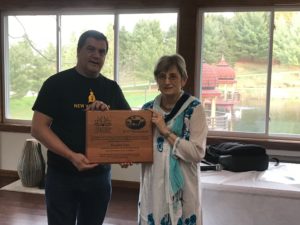
Where is your hometown?
I am a New Yorker by birth. I was born in Brooklyn and brought up in the rural area of Rockland county, near very small town called Spring Valley. At the age of ten, I moved back to NY and lived in Queens.
What initially attracted you to Krishna Consciousness?
I was in high school when Srila Prabhupada was setting up the first ISKCON temple in the East Village. I was initially attracted to the philosophy of Krishna Consciousness. After reading some Buddhist writings called the Diamond Sutra, which I found to be interesting but not that enlightening, my reading created further questions without producing much in the way of answers.
In early 1973, I received a copy of the Back to Godhead (BTG) magazine from a very kind monk who was distributing them in the French Quarter of New Orleans. After reading only two paragraphs of Srila Prabhupada’s lecture, I felt very sure that this was it – the real thing! I knew I needed to find out more.
When did you first meet Srila Prabhupada, and take initiation?
I didn’t have the opportunity to follow up until the November of 1973 when I realized there was a temple in Coconut Grove/Miami. I was staying with my friends in Fort Lauderdale and upon request, they agreed to take me to the temple. I went there with a hope of meeting the person whose lecture I had read in the BTG. I was unsure about whether or not this would be possible but it seemed like the most important thing. I went there with this goal in mind and without any idea of what to expect. As it turned out, I never left, and I met his Divine Grace for the first time in July of 1974 – when he gave me initiation in New Vrindaban.
Can you please tell us something more about your first initiation?
Sure. My first initiation was, of course, wonderful. Whenever and wherever Srila Prabhupada visited on his US tours, there were usually large-scale initiations at that point in time -Advaita, Nirmala, and myself. We all received 1st initiation, and I believe Varsana Swami, and Kasyapa das, received second initiation.
I want to say that many, if not most of the initiates, were from other temples. His Divine Grace presided over the ceremony from a Vyasasan which had been placed on the stone steps above the “driveway”/road which ran between the temple and the hill.
Brahmananda Prabhu gave the lecture and performed the fire sacrifice. I was extremely nervous and unnerved by the thought of having to approach Srila Prabhupada in order to receive my beads- this would be my first close encounter. I was pretty shy, this was a very large group of people when you consider that so many were in New Vrindaban to see His Divine Grace- the largest devotee gathering I had ever been in. I was still quite new and easily intimidated. The walk up to the Vyasasan from my place in the arena seemed endless and climbing those few steps leading up to the Vyasasan, seemed like ascending a great mountain! It may sound dramatic but that is how it felt to me.
Once in front of Srila Prabhupada, I could see his mouth moving but really could barely understand the words he spoke (partly due to the reverberation in the sound system). And, when Prabhupada announced my new name, I was unsure of what he had said. All I could hear was the oohs and aahs from the audience.
When he was uttering my name, I flashed on that passage from the Krsna Book, “Description of the Rasa Dance” where Srila Prabhupada describes that the attractive features of Krsna and the Gopis combined together to appear “…like thunder, clouds, snow and lightning” so, it was quite mystical and I was transported to another realm. Being dazed and delighted, somehow or other, I made it back to my seat. In order to have confirmation of the name I had just received, I had to ask someone sitting next to me.
Also, when did you get 2nd initiation?
I was given the option to receive second initiation along with first initiation, but I declined it due to not feeling ready. My letter of acceptance for 2nd initiation is dated for 11/24/74, however, the fire sacrifice did not take place until a few months later- I want to say February of 1975. I believe that Bimbadhara received 1st initiation at that time.
When did you get married?
I got married to Narada Muni in May of 1974 in Miami. We moved up there in June of 1974, within a month of being married.
When/where did you hear about New Vrindaban?
I was not so aware of New Vrindaban or what was happening there. I had heard of it from the other devotees, who tended to speak about it in a sort of romantic way – open spaces, cows, beautiful deities. So that made me curious to know more about New Vrindaban. Narada on the other hand, was well acquainted with the project and the devotees there – he had previously worked with both Kirtananda swami and Kuladri during the roadshow days. He was an older devotee who knew a lot of people in the movement and was himself, very well known.
When did you move to New Vrindaban?
The Miami temple was in chaos at that moment and Narada wanted to go to New Vrindaban in hopes of finding spiritual stability and I basically agreed! It seemed like a good idea and Miami was becoming unbearably hot!
What were your main services in each decade, 70s, 80s, 90s, 00s, and currently?
In the very beginning, I was assigned to serve breakfast prasadam and then afterwards, clean the prasadam room. In those early months, after initiation, I went on to do things like rolling chapatis and then cooking them on the old wood stoves, dressing chota Gaura Nitai. I was assigned to help Kutila to prepare for Srila Prabhupada’s upcoming visit – to re-do the Vyasasan decorations and to also decorate the Deity srngasana which, at that time, was made of wicker. You can, of course, see it in some of the older Deity photos from Bahulaban.
At one point, I was in charge of picking ALL the flowers and making ALL the garlands for ALL the farms. Amrita Prada was just very new and she was my only helper – and it was summer, so no store-bought flowers!!! We had only wild flowers and whatever was available in the rather small garden of the day.
In the fall of 1974, Narada and I started traveling for raising money by wholesaling Spiritual Sky incense. Later we would sell a jewelry line (Jagannatha Jewelry ) that was produced in Pittsburgh. I believe this continued for the next several years, primarily in the summertime. This was the main service until the end of ’77.
Then later on, Narada was asked to be Temple President of the Columbus center and he opened a very successful Govinda’s restaurant. I became the baker for all the bread and also prepped some other basic menu items – was staying up all night to do this. I would then chant, attend mangal arotik, bathe and dress big Gaura Nitai, and take rest until it was time to start over and go to the restaurant!
The next major service change came when I was summoned to become part of the Palace crew. Myself and Mother Rupa were the only two women on the crew at that time. We started out working with Sudhanu in the casting department, helping prepare the models for casting. These were carved pieces that were going to be installed in the interior of the Palace as baseboards, cornices, window and door frames, etc. Once these were put in place in the interior rooms of the Palace, I was engaged in “touch-up” finishing work – filing in seams and repairing any broken and damaged areas. The idea was to make them look perfect as possible and prepare them for the next step of gold leafing, which I went on to do – EVEN ON THE MAIN DOME (myself, Bhaktiniddhi, and Kuladri). That was pretty crazy, but seemed perfectly normal at the time, OMG!!!
Initially, it was just myself doing this work, then I had one helper and later as the marathon to finish Prabhupada’s Palace progressed, I was organizing the crews of dedicated souls who would come up to the Palace in the evenings, after putting in a full day of service. We had evening crews doing mostly gold leafing or preparing surfaces and mouldings on the exterior of the Palace.
I loved this service best of all. It was a wonderful and sublime meditation on His Divine Grace! I was able to connect with him in very intensely focused manner.
After a bit of a break (and a breakdown from exhaustion), I returned to full-time Palace service to work on the portico, the terrace walls, and all the things that were manifested in the years following the Palace opening.
There was still some traveling sales work going on intermittently as well until spring of 1981 when Narada was diagnosed with cancer and I was simultaneously expecting a child. My main service became taking care of my husband and then the newborn child!
As every New Vrindaban mother can tell you, if you had a baby you would probably end up working in the nursery if you did not wish to surrender to putting your child in there. So I had nursery service for a few years and then came out of retirement to work on the construction of the Sri Sri Radha Vrindaban Chandra temple in the months before the temple opening in 1983.
Also during that time period, Narada was in charge of life membership and started overseeing the guesthouse and was involved with development of the guest cabins as a timeshare program WOW! I almost forgot about that.
There was so much going on during this period of explosive growth and development! It was phenomenal, and you may want to consider Narada to be honored at some point – he was such a powerhouse.
So, I was charged with buying all the curtains and accessories for the cabins. I was responsible for hiring and supervising the cleaning staff for the Temple opening event – that is ALL the cleaning, and set-up of ALL the rooms in the new Temple building. EVERY ROOM, including the prasadam rooms, was set up to accommodate guests with either foam mats, cots or both. And there were about 15 janitors/cleaners working day and night over that festival weekend!
Every guest room in the lodge, every cabin, every room in the new temple building – every room, everywhere was full and I think there were also some tents set up outside. The guesthouse service continued until we ended up leaving the community at the end of 1985. This was originally meant to be a sabbatical, a period recuperation for Narada who had never fully recovered from his bout of cancer. But sadly, things started getting weird in New Vrindaban, Narada fell out of favor with management and we did not return.
In 2001 or 2002, I began attending Festival of Inspiration, helping out with registration and started reviving my New Vrindaban connection then in the next year or so. Gauranga Kishore, our son who took initiation from Radhnatha Swami, returned there to live and serve as a bramachari so I continued to visit more regularly. My major connection with New Vrindaban was revived in 2013 when I came to work for the summer in the guest services department – I was assisting Vasudeva in various ways but mainly as cleaning supervisor. Then I returned for the 2014, and 2015 guest seasons.
Anything specific you’d like to mention about your family? (spouse, children, siblings, parents, etc.)
Gaura Kishore das is my only son and he has a daughter, Rati Keli, who is 7 years old. They now live in Athens, Ohio, and for this reason I am currently living there as well. He is teaching various courses in Philosophy and Ethics at 3 different colleges in the area.
Anything in particular you’d like us to highlight not yet covered?
..I would really like to emphasize that I could only accept any “service award” on behalf of my god brothers and god sisters who were all part of an amazing community effort to make Srila Prabhupada’s vision for New Vrindaban a reality.
I felt like I was just trying to keep up. I felt I was part of something so much bigger than myself and being in the company of so many extraordinary, dedicated souls provided the inspiration that powered (and empowered) us – we were the inmates of New Vrindaban! And the community was everything for us, at that time.
Any advice to newer and future residents? (super important!)
It is important to never take anything for granted such as our service and association with devotees, to remember that this place is not ordinary, and the opportunity to perform service in the holy dhama is something very rare and special.
Keep in mind that, Krsna – Sri Sri Radha-Vrindaban Chandra, is the actual in-charge here, and He will always be the one in control! Even when it may seem otherwise. Please take care of the Deities and They will take care of you. Take care of one another and also take care of yourself – try to maintain a healthy balance between body, mind, and spirit.
ECO-Vrindaban Board Meeting Minutes 10/29/2017
ECO-Vrindaban Board Meeting Minutes 10/29/2017
Mission Statement: ECO-Vrindaban promotes simple living, cow protection, engaging oxen, local agriculture, and above all, loving Krishna, as envisioned by Srila Prabhupada, the Founder-Acharya of ISKCON New Vrindaban.
Participating Directors: Chaitanya Mangala (chair), Kripamaya, Ranaka, and Vraja.
Participating Advisors: Bhima, Jamuna Jivani (secretary), Jaya Krsna, Kalakantha, Makara, and Olivia.
1. Ranaka’s Monthly Report
- Ananda Vidya is milking six cows. Milk production is approximately 19 gallons per day.
- The veterinarian checked Malati and now estimates her due date between November and December. Sriya and Anjali are both due in February.
- There are three heifers residing at the Temple Barn: two-month-old Lalita, 10-month-old Vamsika, and 19-month-old Jaya Radhe. Subhadra has been moved to Nandagram for breeding with Madhu.
- Ananda Vidya continues to produce 10-12 lbs. of butter, 15 gallons of yogurt, and 1/2 gallon of ghee on a weekly basis, and delivers them to the temple. He purchased a small cheese press and has been experimenting with making colby cheese. This may be one way to process excess milk during the winter months.
- The children from Gopal’s Garden came to the Temple Barn on Govardhan Puja to decorate the cows and feed them molasses balls, and drank warm milk.
- During the farm conference, six or seven participants came over to the barn to assist with morning milking and become familiar with the cows.
- The 2017 North American Farm conference was held at New Vrindaban on the weekend of October 13-15. We had a good turnout with approximately 40 people over the three days. Everyone seemed quite satisfied, as old relationships were rekindled and new acquaintances were made.
- The potato harvest, washing, and storage is complete for the year, although with a disappointing approximate yield of only 1,000 lbs. due to an exceptionally wet spring.
- Ray completed replacing of the underground electric line to the Nandagram pasture cabin and now the electricity has been restored. Also, he has made progress on Dharma the Bull’s outside pen expansion project at the Valley Barn, as well as on pressure washing and painting the valley board fences, when the weather has allowed. Spreading manure, chisel plowing, and disking areas in the Temple Garden still need to be done and will be pursued if the ground is dry enough. Otherwise, they will have to wait until spring.
- Nila Gopala and his family departed for Hungary last Friday, leaving on good terms. He had completed about 80% of the work on Madhu the Bull’s shed and pen project at Nandagram. Caitanya Bhagavat (and Ray, if needed) will finish the project.
- Caitanya Bhagavat and Balabhadra prabhu gave a ox training demonstration at Nandagram during the recent farm conference. Hari Chand showed he had been well-trained and well-cared for.
- Caitanya Bhagavat continues to work with the ox, Hari Chand, for 1.5 hours every morning, along with Nandagram herd care, fence maintenance, and completing Madhu’s pen and shed.
- Robert and Ranaka, along with input from Suchandra and Lila, have been working on compiling the end of the year flower and vegetable harvest totals, as well as pricing for the 2017 INV billing. The figures should be ready by the next monthly board meeting.
- Robert has expressed an interest to learn how to operate farm equipment along with general building and fence maintenance, etc. Currently, he is assisting Ray with Dharma’s outside fence expansion project at the Valley Barn. Also, he is receiving training on operating farm equipment, and on milking.
- Suchandra and Vidya will be giving a presentation at the upcoming joint board meeting
2. New Board Candidates
Currently, the Board has two open seats. In January, the Board will vote on the seats of the directors whose terms are expiring and review candidates for available seats. Individuals interested in getting involved with ECO-V can contact Ranaka.
3. Employee Manual
Vraja proposed an employee manual which will provide job descriptions for the various positions and outline company policies. She will work on a draft, to which others are invited to contribute and offer feedback.
4. Improving Community Culture
The Board discussed concerns over devotees, including those involved in ECO-V, leaving the New Vrindaban community due in part to considerable negativity within its culture. Several ideas were offered on how we can help to create a more positive atmosphere, both as an organization and as individuals.
5. ECO-V Website
Previously, Jamuna Jivani collected and wrote content for the website. Also, Sukhayanti contributed photos and text. Jaya Krsna and Makara are contributing photos to use.
6. Communication Person for IMCPA
Kalakantha requested Jamuna Jivani act as a liaison between ECO-V and the ISKCON Ministry of Cow Protection and Agriculture. The Board agreed to this arrangement.
7. 2017 Farm Conference Recap
Jamuna Jivani reported on the North American ISKCON Farm Conference that took place in New Vrindaban earlier in the month. New Vrindaban created a very pleasant setting for the conference with incredible support and service, and a beautiful facility. The whole conference ran smoothly, and the interactions among the participants were inspired. There were approximately 40 participants from USA, Canada, and Guyana. From ECO-V, Ranaka gave a tour of the Valley Barn facilities and spoke about New Vrindaban’s history of cow protection. Makara gave an informative seminar on water bath canning. Both Lalita Gopi and Ranaka were panelists in the Ahimsa Dairy Equation panel discussion.
The plan for future years is to have a similar, but larger, biennial conference, with small organizing conferences in between. IMCPA is currently scouting locations for future events. ECO-V offered to host again in 2019, which will mark the 50th anniversary of cow protection in New Vrindaban.
8. Autumn 2017 Joint Board Meetings
The upcoming joint board meetings in New Vrindaban will be held the weekend of November 10-12.
For regular updates please visit and like the ECO-V Facebook page.
Syama Kunda’s Brijabasi Spirit Interview – November 2017
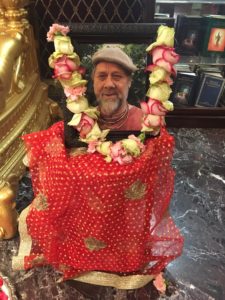
Where is your hometown?
Syama Kunda was raised in Cambridge, Maryland.
When & where did you get married?
While living in Maryland in 1969, Syama Kunda met his wife Girindra Mohini, the youngest girl of 10 siblings. When he was 16 and she was only 15, they were married by her minister father.
When did you first meet devotees?
Syama Kunda initially saw the devotees chanting on the streets of Greenwich Village, New York City while on his way to Canada. He thought they had taken too many drugs. Later, while in a mall in Denver, CO, Syama Kunda and his wife met Kamalavati Dasi (also a long time NV resident), who gave them their first book: “Krsna, The Reservoir of All Pleasure.”
What initially attracted you to Krishna Consciousness?
Syama Kunda was a Beatle kid and had been listening to George Harrison’s “My Sweet Lord” regularly. In 1971 while working in Denver, he met some vegetarians. One day while visiting their home, he saw a Krsna Book on their counter. The attractive red picture of Radha and Krsna standing together, grabbed his attention and he asked: “Where did you get this?” They said a few Hare Krsna devotees had come by yesterday. Syama Kunda was searching for real love, the love of sisters, brothers and friends. The Beatles songs inspired Syama Kunda & he felt if the Beatles were into Hare Krsna, it was worth checking out.
When & where did you first join ISKCON?
After receiving the booklet on Krsna in the mall, Syama Kunda and his wife decided to go to the Sunday Feast at the Denver temple. Here Syama Kunda approached the Denver temple president about moving in and becoming a full time devotee
When/where did you first hear about New Vrindaban?
Syama Kunda first read about New Vrindaban in a Back to Godhead magazine. The temple president of ISKCON Denver, who happened to be Tulsi das (who lives in NV), suggested that since Syama Kunda was a married man with a son, they go to New Vrindaban where there was space for families and that his talents as a carpenter would also be much appreciated there.
When did you move to New Vrindaban?
Syama Kunda and family moved to New Vrindaban in 1971.
When & where did you get initiated?
Syama Kunda was initiated on Janmastami day, 1972 at the Bahulaban temple in New Vrindaban during the Bhagavat Dharma Discourses given by Srila Prabhupada. Both he, his wife, along with Mother Kunti devi (Karnmarta’s mother) were all initiated the same day.
What is your favorite part of New Vrindaban?
In the early days at New Vrindaban, Sri Sri Radha Vrindaban Chandra were Syama Kunda’s favorite part. Currently, his favorite part is Radha Kunda at Govardhan Hill near the Sri Sri Radha Gopinath Temple. This Holy Dham is non-different from Krsna. And when everyone is engaged in devotional service, New Vrindaban is non-different from the spiritual world.
What were your main services in each decade, 70s, 80s, 90s, 00s, current?
Since Carpentry was his forte, in the 70’s Syama Kunda was instrumental in the construction of the facilities at Bahulaban which were needed to expedite the building of Srila Prabhupada’s palace: This included the first barn (the home of the first cows and many of the first devotees), the utility building (which comprised housing, the mold shop, the marble shop, the wood shop), along with the guest house. After leaving New Vrindaban in the 80’s, Syama Kunda went on to renovate the Tucson, Arizona temple and later on he spent considerable time in the Los Angeles temple working on a number of renovations, including Srila Prabhupada’s bookcase in the temple room.
What was your favorite service?
Although he only spent his early years in New Vrindaban as a pujari, it was by far his favorite seva. He fondly remembers waking The Deities every morning before work and then putting Them to rest in the evenings. Sunday was the most special day. He would roam around New Vrindaban to gather flowers, branches and even moss to decorate the altar so that it would appear just like the forests of Vrindavan. Each Sunday he would strive to make the decorations more and more opulent.
Anything specific you’d like mentioned about your family?
Syama Kunda was happy that 8 of his children were born in New Vrindaban Dham. His daughter Vishakha was the first girl born here. He was also very grateful that his son, Kiba Jaya, had the opportunity to personally stand near Srila Prabhupada and receive a cookie from his hand. Kiba jaya also got to travel to India. Syama Kunda feels very grateful that his family had the opportunity to participate in Krishna Conscious village life in the early days.
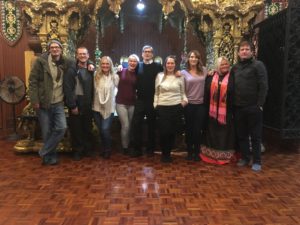
Anything in particular you’d like us to highlight not covered above?
Although Syama Kunda began his devotional life in New Vrindaban, after leaving he spent a lot of time in the Los Angeles temple which became his 2nd home. The more he gazed upon Rukmini on the altar (Rukmini-Dwarkadish), the more She captured his heart. She made Syama Kunda cry for Krsna. So the highlight for him was working at the LA temple while begging for the mercy of Sri Sri Rukiimini-Dwarkadish.
Any advice to newer and future residents?
In the beginning of New Vrindaban, reading Srila Prabhupada’s books was put on the back burner in order to do the needful for the development of this Holy Dham. Syama Kunda felt there was a lot of misunderstanding of Prabhupada’s teachings but that has since been rectified by an increase in focus on his instructions. Syama Kunda encourages everyone to take 20 to 30 minutes every day to read Prabhupada’s books. This keeps us in a personal relationship with him.
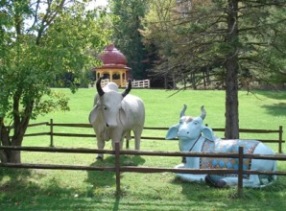
Welcome to Brijabasi Spirit
Thank you for taking the time to visit the New Vrindaban community blog. Think of visiting our blog as making a virtual pilgrimage.
Hare Krishna Hare KrishnaKrishna Krishna Hare Hare
Hare Rama Hare Rama
Rama Rama Hare Hare
"May cows stay in front of me; may cows stay behind me; may cows stay on both sides of me. May I always reside in the midst of cows."
Hari Bhakti-vilas 16.252
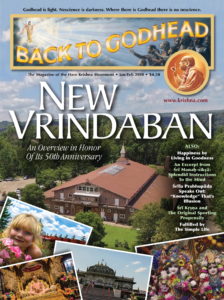
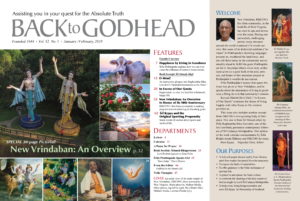
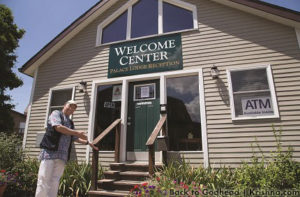
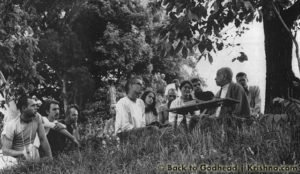
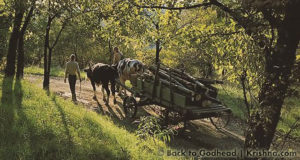
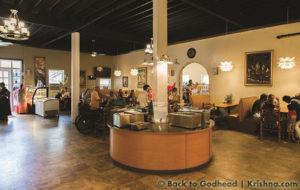
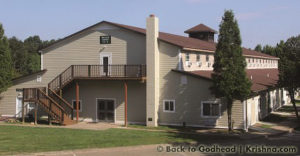

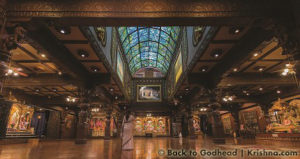
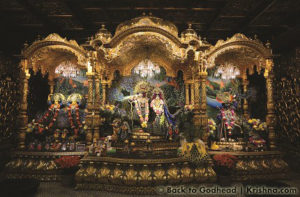
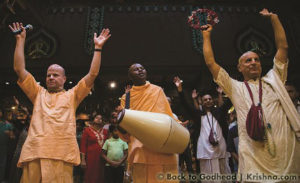
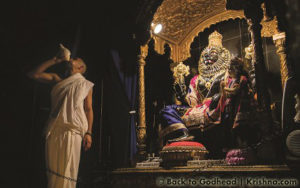
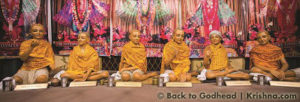
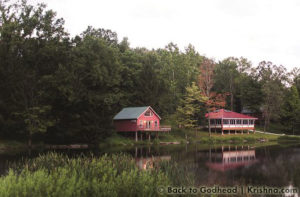
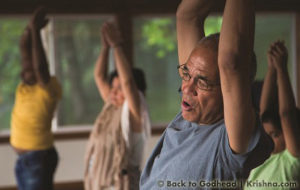
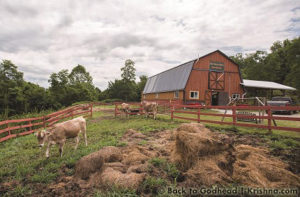
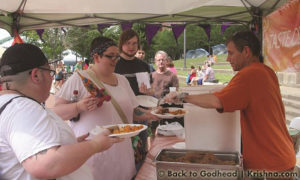
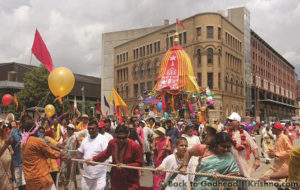
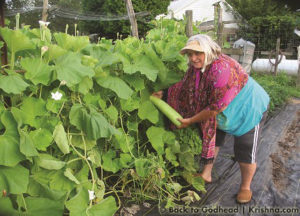
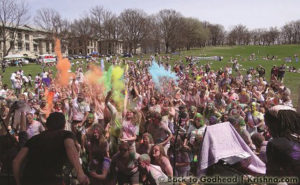
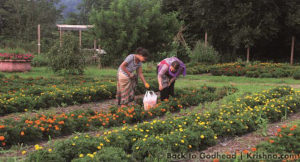
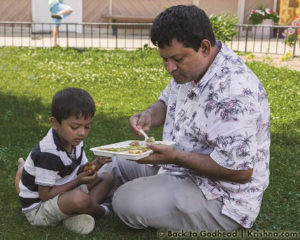
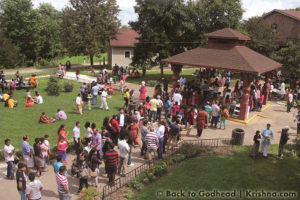
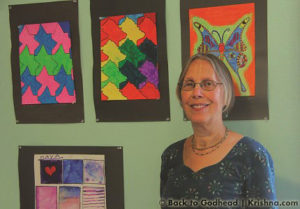
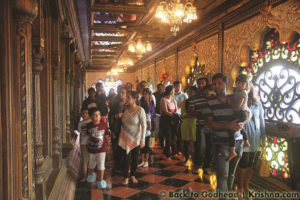
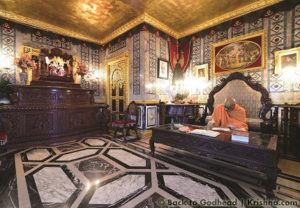
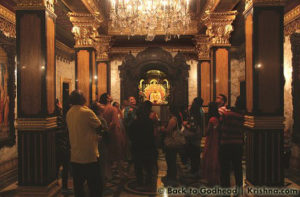
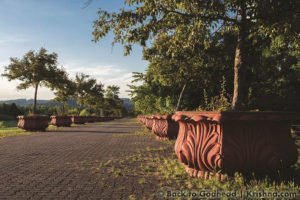

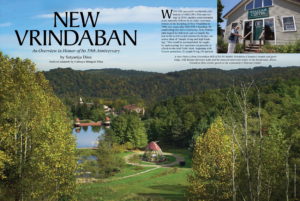
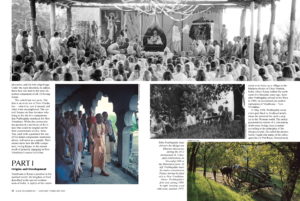
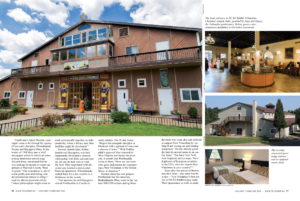
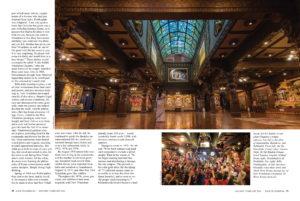
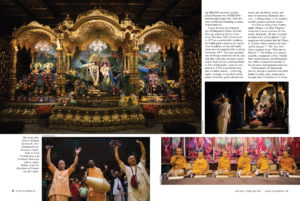
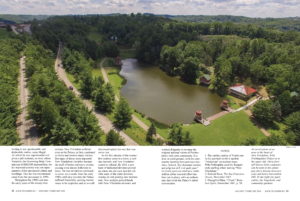
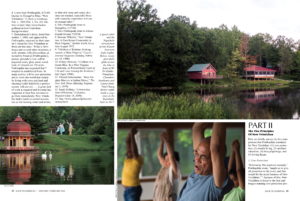
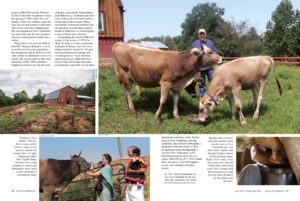
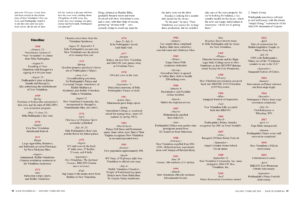
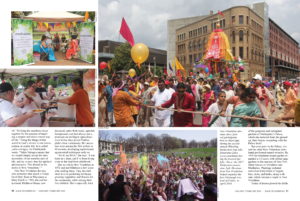
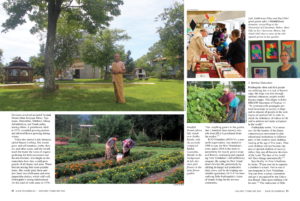
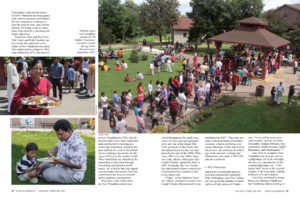
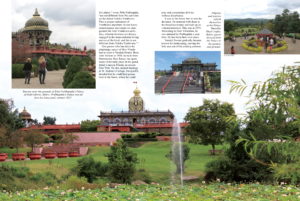
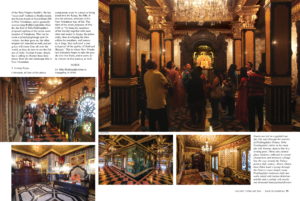
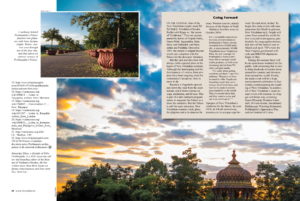
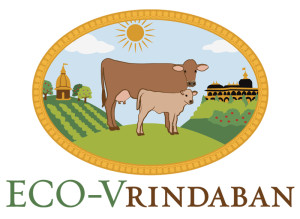
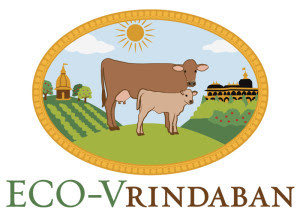
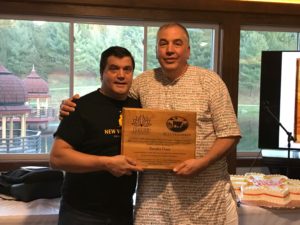
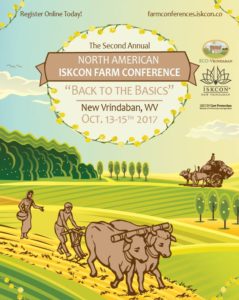




Recent Comments